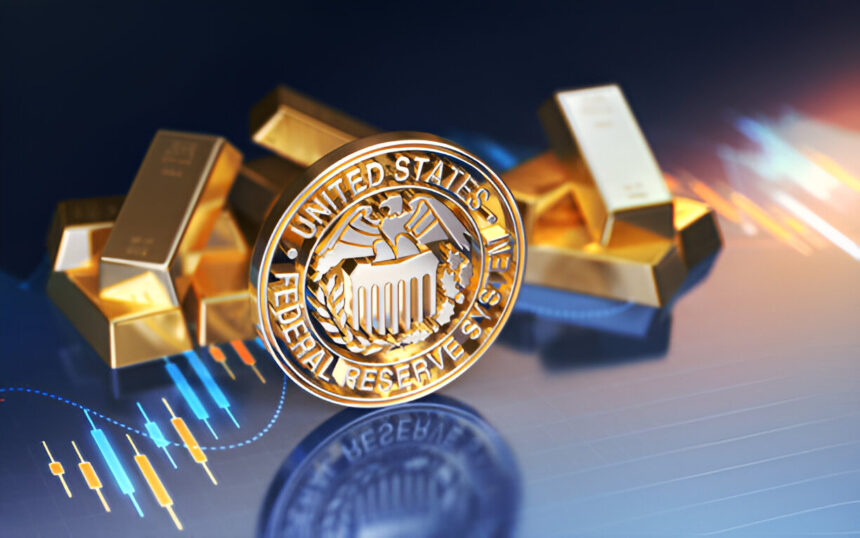Gold reached a new all-time peak of $3703 per ounce on September 17, 2025, which is higher than the inflation-adjusted peak of 1980. A variety of macroeconomic factors precipitated a significant surge that lasted for an entire year. The market is eagerly anticipating the Federal Reserve’s upcoming policy announcements and concerned about how the gold will react to the Federal Reserve’s adjustments. A 25 basis point (bp) rate cut has already been largely factored in. Being an analyst and a trader who has experienced numerous market cycles, let me tell you that the “dot plot”, Powell’s press conference, and the Federal Reserve’s statements are of immense significance.
What is the reason for the significant increase in gold prices?
Before discussing the various possibilities, it is important to understand the reasons behind the 43% increase in gold prices this year. This rally is not merely a collection of empty words; it is founded on three solid foundations:
The dollar is experiencing a decline in value. The dollar and gold typically move in opposite trends. The U.S. Dollar Index (DXY) has decreased by approximately 10.3% this year, suggesting that gold is now more affordable for individuals who possess other currencies. This trend is anticipated to persist as the Federal Reserve seems ready to reduce rates.
Gold does not generate interest or dividends, but when interest rates and, more importantly, real yields (interest rates minus inflation) decrease, it becomes a more advantageous investment. Rates are likely to decrease, and with inflation around 2.9-3%, real yields will decline significantly, boosting gold’s appeal. Additionally, uncertainty in institutional and retail investor sentiment, driven by geopolitical and economic risks, is likely to further support gold prices.
Central banks are requesting an unprecedented amount of capital, as they acquire assets with a long-term strategy, unlike institutional and retail investors, who may be unpredictable. Central banks anticipate purchasing over 900 tonnes of gold in 2025, with approximately 483 tonnes acquired YTD through August. This ongoing, non-speculative demand drives up the price of gold. This significant shift in the demand is one of the primary factors contributing to the increase in gold prices.
The Federal Reserve’s Policy and Its Potential Impact on Gold Prices
The market has already priced in a 25 basis point rate cut, which has a 97.5% likelihood. This shows that a minor cut will not have a major impact. The market’s actual response will depend on the specific statement issued by the Federal Reserve. The objective of the game is to determine Powell’s true intentions. The outcomes may manifest as follows:
Scenario 1: The Expected 25 bp Cut and Neutral-to-Dovish Guidance (Probability: 97.5%)
This opinion is held by the majority of analysts. The Summary of Economic Projections (SEP), also known as the “dot plot,” is a more significant event than the Federal Reserve’s 25 basis points cut in the federal funds rate. If the dot plot indicates a trajectory of two to three reductions for the remainder of 2025, it indicates that the market’s perception is accurate. Recent labour statistics, such as the disappointing +22,000 nonfarm payrolls, would undoubtedly be discussed during Powell’s press conference, and the Fed’s data-dependent strategy would also be acknowledged.
The Gold Reaction: It is probable that the price will increase gradually and continuously by 1% to 3%, resulting in a price range of $3,740 to $3,780 per ounce. Although the reduction has already been factored in, a dovish stance could result in additional reductions if the economy remains unfavourable, which would cause prices to rise. As the U.S. dollar continued to decline, so would real yields. Any “sell the news” decline should not ring any alarms. It is probable that the trend will reemerge as traders contemplate its implications for the long term.
Scenario 2: An exceedingly dovish surprise (probability: approximately 2.5%)
This is the exceptional circumstance that could result in a parabolic movement. The Fed has two options: either they could reduce rates by 25 basis points and align this with an exceptionally dovish Dot Plot, resulting in a rate decline of 100 basis points or more by the end of the year, or they could reduce rates by 50 basis points without prior notice. This would be a significant shift for the Federal Reserve, as it would indicate that they are aware that the economy is becoming more risky at a quicker pace than they had previously anticipated.
The Gold Reaction: The price is expected to increase by 4% to 7%, reaching a range of $3,860-$3,940/oz. This would be a clear indication that the Federal Reserve is initiating a significant easing program, most likely due to the economy’s anticipated slowdown. If the DXY falls to this low, individuals worldwide would be inclined to purchase gold, as the actual yields would be nearly nonexistent. Similar fluctuations have occurred at the commencement of previous relaxation cycles. It is probable that the momentum will propel the gold prices towards $4,000.
Scenario 3: The Hawkish Cut or No Cut (Chance: 0.5%)
This situation is low-risk but has a substantial effect. The Fed may opt to maintain the current rate, asserting that the lethargic job market is merely a temporary issue and that the primary concern is the inflation (around 3%) that is unabated. They have the option to reduce the rate by 25 basis points; however, Powell’s statements and the dot map indicate that the easing route is relatively limited (e.g., only one reduction for the remainder of the year).
Gold Reaction: The price would experience a rapid and precipitous decline of 3–5% to the $3,500–$3,550/oz level in the event of a direct influence. Although this would be a disagreeable setback, it is unlikely to persist for an extended period. The cost of holding gold will increase if interest rates remain high for an extended period; this would prompt individuals to sell gold, but the structural support, such as the ongoing demand from central banks and gold’s status as a hedge against inflation and geopolitical risk, should prevent the complete collapse of the situation. Long-term investors can consider a purchase at this time in such a scenario if developed.
I remember that in the early 2000s, there was widespread belief that the Federal Reserve would take action. The press conference fundamentally altered the public’s perception. Initially, the dollar experienced a significant increase; however, the market promptly declined within a day as traders scrutinised the fine print and comprehended the long-term implications of the dot plot. The initial headline is not as critical as the genuine “intent” of the central bank’s guidance, which is the fundamental signal.”
Conclusion
The recent increase in gold is not merely a rally; it is a signal that the world is becoming more perilous. The pricing already indicates that there is optimism that the Federal Reserve will loosen its monetary policy. However, there is still hope for the future. The price is likely to rise to $3,800–$4,000 by the end of 2025, contingent upon the Fed’s dovish stance. The risk is a “hawkish” stance that can result in a short-term decline and allow investors who missed the initial spike to enter the market. If the price declines, particularly if it coincides with a hawkish cut, one may wish to increase their positions. There are still structural drivers, central bank purchases, geopolitical concerns, and high inflation. This is a long-term scenario, due to the evolving global economy and politics, not just a simple trade.
Disclaimer: This blog is for informational purposes only and does not constitute financial advice. Always conduct your own research and consult a professional advisor before making investment decisions.







